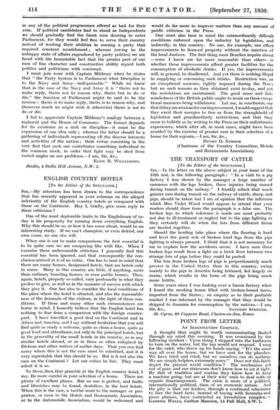THE TRANSPORT OF CATTLE
[To the Editor of the SPECTATOR.]
SM,—In the letter on the above subject in your issue of the lath inst. is the following paragraph : " In a visit to a pig factory I was shown by the manager a large number of carcasses with the legs broken, these injuries being caused during transit on the railway." I frankly admit that much greater care during transit on the railway of cattle, sheep, and pigs, should be taken but I am of opinion that the inference which Miss Violet Wood would appear to intend that y our readers should draw from the paragraph is a false one. The broken legs to which reference is made are most probably not due to ill-treatment or neglect but to the pigs fighting as they certainly will do when the lots from different farms are herded together.
Should the herding take place where the flooring is hard and level the great risk of broken hind legs from the pigs fighting is always present. I think that it is not necessary for me to explain how the accidents occur. I have seen three broken legs result from a fight on a brick floor between two strange lots of pigs before they could be parted.
The loss from broken legs of pigs is proportionately much greater in the United States than in this country, owing mainly to the pigs in America being fattened, fed largely on maize, which results in the bone of the pigs being much more brittle.
Some years since I was looking over a bacon factory when I found the smoking house filled with broken-boned hams, imported from the States ; on enquiry as to their probable market I was informed by the manager that they would be shipped to Jamaica for consumption by the natives.—I am,


































 Previous page
Previous page